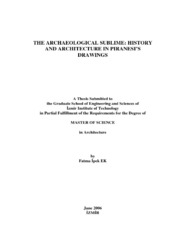Please use this identifier to cite or link to this item:
https://hdl.handle.net/11147/3439Full metadata record
| DC Field | Value | Language |
|---|---|---|
| dc.contributor.advisor | Şengel, Deniz | - |
| dc.contributor.author | Ek, Fatma İpek | - |
| dc.date.accessioned | 2014-07-22T13:51:32Z | - |
| dc.date.available | 2014-07-22T13:51:32Z | - |
| dc.date.issued | 2006 | - |
| dc.identifier.uri | http://hdl.handle.net/11147/3439 | - |
| dc.description | Thesis (Master)--İzmir Institute of Technology, Architecture, İzmir, 2006 | en_US |
| dc.description | Includes bibliographical references (leaves:144-176) | en_US |
| dc.description | Text in English; Abstract: Turkish and English | en_US |
| dc.description | xxi, 176 leaves | en_US |
| dc.description.abstract | In the architectural, historical, and archaeological context of the eighteenth century, Italian architect Giovanni Battista Piranesi (1720-1778) played an important role. He posited crucial theses in the debates on the 'origins of architecture' and 'aesthetics'. He is numbered foremost among the founders of modern archaeology. But Piranesi was misinterpreted both in his day and posthumously. The vectors of approach yielding misinterpretation of Piranesi derived from two phenomena: one is the early nineteenth-century Romanticist reception of Piranesi.s character and work. The second is the mode of codification of architectural history. The former interpretation derived from Piranesi.s position on aesthetics, the latter from his argument concerning origins. Both of these served the identification of Piranesi as .unclassifiable.. He has thus been excluded from the 'story' of the progress of western architectural history.Piranesi, however, conceived of these two debates as one interrelated topic.Concerning origins, he developed a history of architecture not based on the East/West division, and supported this by the argument that Roman architecture depended on Etruscans which was rooted in Egypt. Secondly, he distinguished Roman from Grecian architecture identified with 'ingenious beauty'.Thus Piranesi placed Romans in another aesthetical category which the eighteenth century called 'the sublime'.Piranesi's perception caused him to be described as madman or idiosyncratic. However, most of these evaluations lack a stable historical base. Therefore, restoring Piranesi, his arguments, executed works and drawings to architectural history appear as a necessity. | en_US |
| dc.language.iso | en | en_US |
| dc.publisher | Izmir Institute of Technology | en_US |
| dc.rights | info:eu-repo/semantics/openAccess | en_US |
| dc.subject.lcc | NC257.P48 .E36 2006 | en |
| dc.subject.lcsh | Piranesi, Giambattista, 1720-1778 | en |
| dc.subject.lcsh | Piranesi, Giovanni Battista, 1720-1778 Contributions in architecture | en |
| dc.subject.lcsh | Piranesi, Giovanni Battista, 1720-1778--Contributions in design | en |
| dc.subject.lcsh | Architecture, Modern--18th century | en |
| dc.subject.lcsh | Architecture--Rome | en |
| dc.title | The Archaeological Sublime: History and Architecture in Piranesi's Drawings | en_US |
| dc.type | Master Thesis | en_US |
| dc.institutionauthor | Ek, Fatma İpek | - |
| dc.department | Thesis (Master)--İzmir Institute of Technology, Architecture | en_US |
| dc.relation.publicationcategory | Tez | en_US |
| dc.identifier.wosquality | N/A | - |
| dc.identifier.scopusquality | N/A | - |
| item.grantfulltext | open | - |
| item.openairecristype | http://purl.org/coar/resource_type/c_18cf | - |
| item.fulltext | With Fulltext | - |
| item.cerifentitytype | Publications | - |
| item.languageiso639-1 | en | - |
| item.openairetype | Master Thesis | - |
| crisitem.author.dept | 02.02. Department of Architecture | - |
| Appears in Collections: | Master Degree / Yüksek Lisans Tezleri | |
Files in This Item:
| File | Description | Size | Format | |
|---|---|---|---|---|
| T000527.pdf | MasterThesis | 45.91 MB | Adobe PDF |  View/Open |
CORE Recommender
Page view(s)
476
checked on Jul 7, 2025
Download(s)
1,580
checked on Jul 7, 2025
Google ScholarTM
Check
Items in GCRIS Repository are protected by copyright, with all rights reserved, unless otherwise indicated.